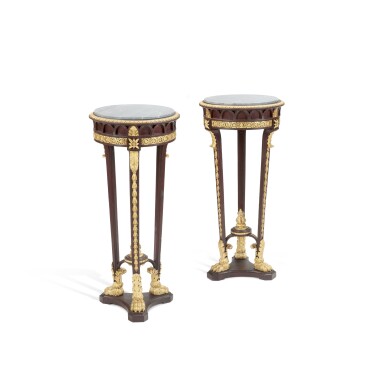The Giordano Collection: Une Vision Muséale Part I
The Giordano Collection: Une Vision Muséale Part I

A pair of Italian parcel-gilt and painted jardinières, Royal Workshops, Turin, late 18th century
Auction Closed
November 26, 04:58 PM GMT
Estimate
40,000 - 60,000 EUR
Lot Details
Description
of athénienne shape, with a later movable blue Turquin marble top above a copper liner, on tripartite base ending in hairy paw feet, with an ink mark PPS722, on the reverse of the frieze a label inscribed Reale Palazzo di Torino, No 234 and 235
(2)
Height. 35 ¾ in, diam. 15 ½ in ; Haut. 91 cm, diam. 39,5 cm
Royal Palace, Turin ;
Collection of Giuseppe Rossi;
Sotheby's London, The Italian furniture from the estate of the late Giuseppe Rossi, 10 March 1999, lot 64, with the label Palazzo Reale, Torino;
Christie's New-York, Important European Furniture, 18 May 2006, lot 810.
R. Antonetto, Il mobile piemontese nel Settecento, Turin, 2010, p. 371, cat. nr. 30.
Genio e Maestria. Mobili ed ebanisti alla corte sabauda tra Settecento e Ottocento, Reggia di Venaria, 2018, p. 261, cat. nr. 46.
G. Ferraris, Giuseppe Maria Bonzanigo e la scultura decorativa in legno a Torino nel periodo neoclassico (1770-1830), collana europe arte, Turin, 1991
Genio e Maestria. Mobili ed ebanisti alla corte sabauda tra Settecento e Ottocento, Reggia di Venaria, 2018.
According to the label reading "Reale Palazzo di Torino" and the inventory numbers "234" and "235" stamped twice, this pair of jardinières once graced Turin’s Royal Palace, where much of the finest Italian neoclassical furniture still resides. Inspired by the grand antique tradition of tripods, these jardinières majestically rise from a tripartite base with intricately carved paw feet, showcasing a rich neoclassical design with gilt carvings set against a contrasting painted wooden background. Among the highly skilled craftsmen who worked at the Royal Palace, two stand out for their style and quality in the production of similar pieces to these jardinières: Giuseppe Maria Bonzanigo (1745-1820) and Francesco Bolgiè (1752?-1834).
These jardinieres were executed at a time when carvers like Bonzanigo departed from the traditional school of Franco-Piedmontese inlay and marquetry cabinet-making, in favour of a more predominant use of carving. See a comparable example forming a pedestal at Castle of Agliè near Turin (ill. E. Colle, Il Mobile Impero, Milan, 1998, pp.354-357, cat. Nr. 4), clearly influenced by the work of Bonzanigo. Giuseppe Bonzanigo was born in Turin to a family of wood carvers; his fame and reputation were sealed quite early in his career due to the extraordinary quality of the decorative wood carvings “microscultura” which he made. He was granted the patronage of the Royal family in 1773 and in 1774 he was elected to the Academia di San Luca. In 1787, he was appointed official woodcarver to the Crown.
In the accounts of the royal family, he is recorded as having supplied numerous stools, chairs, armchairs, benches, sofas, screens, beds and mirrors as well as many ornamental panels and chests of drawers for the Royal Palace of Turin and for the royal residences at Moncalieri, Rivoli, Stupinigi, Venaria. For example, a work table in Palazzo Madama and attributed to Bonzanigo is similar to the present piece (see Antonetto, op.cit., p.365, cat. Nr. 21), as they share the paw feet and a comparable language with neoclassical foliate friezes. Whilst there are no jardinieres or planters mentioned in the bills for Bonzanigo, two tripods are documented. Made by Bonzanigo as tripods to support sculptures for the Duke of Aosta's boudoir in the Royal Palace, one of them was converted into a planter (ill. Antonetto, op.cit., p.358, cat. Nr. 15). This example suggests the present jardinières may also originally have been intended as tripods.
The research of art historian Giancarlo Ferraris has brought to light the work of Francesco Bolgiè who was a carver at the court of the King of Sardinia and whose skills often match those of the more renowned Bonzanigo. In light of archival research, it has been possible to attribute with certainty to Bolgiè several pieces of furniture delivered between 1775 and 1799 to the Savoy court. These pieces are still present in the royal collections, namely the corner cupboard-consoles, the green and parcel-gilt commode and the balustrade in the Royal Palace of Turin and the famous blue and ivory painted bookcase/secretaire at Stupinigi (ill. Antonetto, op.cit., respectively pp.374-375, p.376, pp.380-381, pp.386-387).
Attributed to Bolgiè, but initially believed to be Bonzanigo’s work, an oval table also converted from a tripod, with a similar guilloche frieze to the present lot was supplied to the Gabinetto di toeletta of Madama Felicita at the Palazzo Reale (see Antonetto, op.cit., p.365, cat. Nr. 21). Other tripods by Bolgiè include a set of four, still unknown to date, which were intended for the royal apartments and recorded on a bill to Francesco Bolgiè on 16 November 1823. The set of commodes attributed to Bolgiè notably with downward laurel garlands on the legs at Stupinigi and Palazzo Reale, are also interesting comparables (see Antonetto, op.cit., p.365, cat. Nr. 21).
You May Also Like










